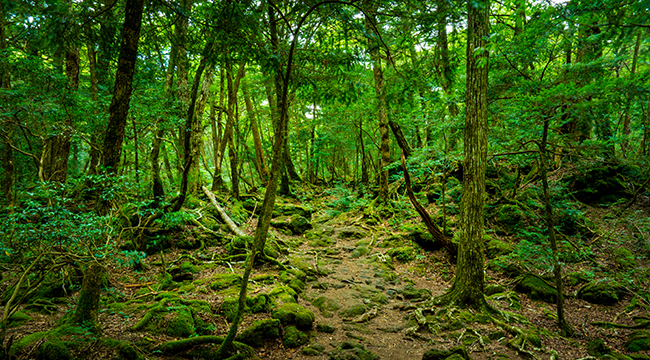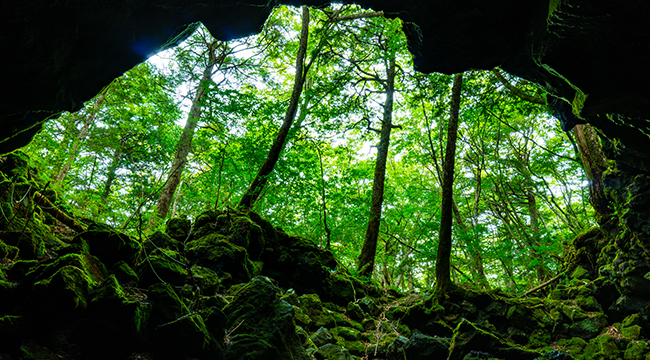
On the northwestern flank of Japan’s most famous mountain sits one of the world’s quietest forests — Aokigahara or the “sea of trees.” In the west, it’s in the news today thanks to a YouTube video from the controversial social media celebrity Logan Paul, which he quickly pulled and apologized for.
The video features Paul finding the corpse of a man who committed suicide on the trail and focuses on the man for several minutes. Many felt the video was deeply disrespectful of the dead, and Paul has continued to apologize, as criticism has mounted. Lost in all this is the forest itself and the complicated role it holds as both a natural and cultural landmark.
Aokigahara, as a natural feature, is a forest northwest of Mt. Fuji — famous for its quiet hiking trails. Relatively little wildlife lives in Aokigahara, and the forest is old growth on a bed of volcanic rock, meaning sound doesn’t echo or travel very far. It’s also home to some of Japan’s more beautiful ice caves, which are frozen year-round. Scenery-wise, it’s one of the most beautiful places in the country.
It’s also the site of quite a few suicides. Authorities have stopped reporting the number of suicides in the forest in order to reduce its reputation as a place to die, but since 1970, officers have quietly patrolled the forest to retrieve bodies there, usually finding between fifty and one hundred bodies per year.
How this is treated in the West, though, reflects a larger cultural problem about Japan — namely a lack of perspective about its culture. While most Westerners have vague ideas of “honor” and “hara kiri” or “seppuku”, we have to remember that every culture has a complicated relationship with suicide. If we talk about a play where two lovers kill themselves, hemmed in by a tragic web of social circumstances, are we talking about Romeo And Juliet or Shinjū Ten no Amijima? What distinguishes Aokigahara from the Golden Gate Bridge as a spot where people choose to end their lives? Suicide is a vast social and psychological issue that’s outside the context of this post, and similarly, different societies approach this problem in vastly different ways.
Cross culturally, the issue is more straightforward: We, as a people, tend to write off or ignore suicide. But when it happens in another culture, we treat it like a spooky ghost story. That’s not good.

Unfortunately, Paul is far from the first Westerner to treat Aokigahara in a callous way. Rumors (which are false) abound that compasses don’t work there, urban legends about the alleged practice of ubasute (leaving the elderly to die of exposure) in the forest are everywhere despite little evidence it was ever practiced anywhere in Japan, and less than two years ago a horror movie hit theaters based around the “legends” in the forest, which was mostly bunk. Aokigahara sits at an unfortunate nexus that reveals the insensitivity even well-meaning Westerners can view foreign cultures with.
This leaves travelers with an ethical conundrum that’s tough to solve: Aokigahara is a beautiful place, and it’s located near one of Japan’s most compelling and popular natural features. But should you visit? Or is it a little like taking a selfie at Auschwitz? What are the burdens on travelers who want to see the wonders, but worry about being disrespectful and falling afoul of another culture’s struggles?
In the end, the issue of whether or not to visit a cultural site while traveling comes down to questions of empathy. Why are we going to this place? What do we plan to do there? And how does the culture that values this place the most view our actions? That last question may be the hardest one to answer, especially for cultures where there’s little shared historical ground. And sometimes there aren’t any easy answers to these questions. It’s not until you visit another place, or explore its culture in any true detail, that you learn just how much the culture we grew up in affects how we see things. It’s easy to empathize with somebody in your own culture, but outside it, you may be starting largely from zero.
This is messy work, but the conscious backpacker needs to engage in it. Travelers have to confront themselves with their motives and put themselves in the shoes of the culture they’re visiting or there’s no point to travel. Part of the goal of travel is to view the world from more than one perspective. We cannot demand that the cultures we visit shove themselves aside or fit in the tidy little box we’ve created for them. No nation is a theme park, and no graveyard is our haunted house.
https://www.instagram.com/p/BdUu6kDFCw3/






